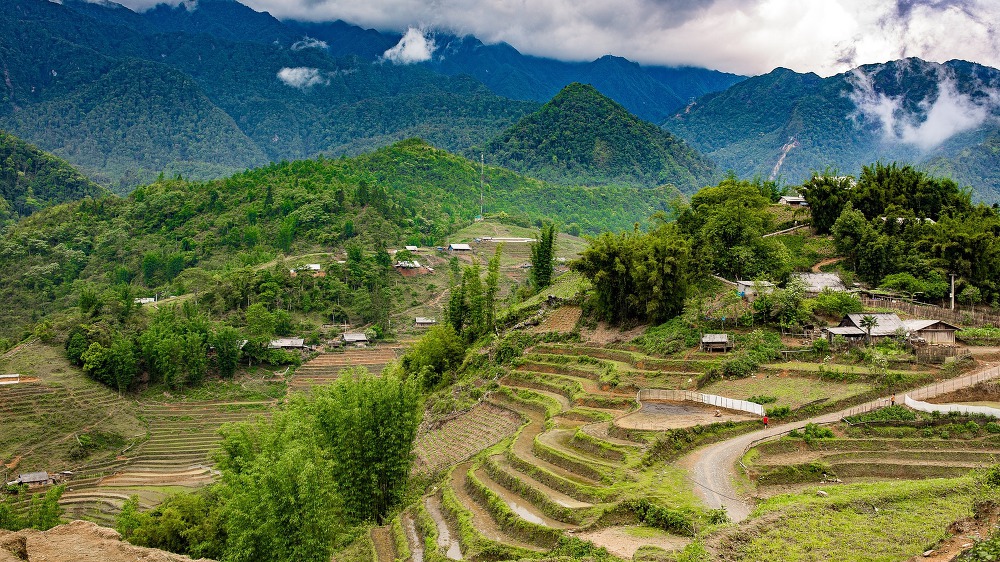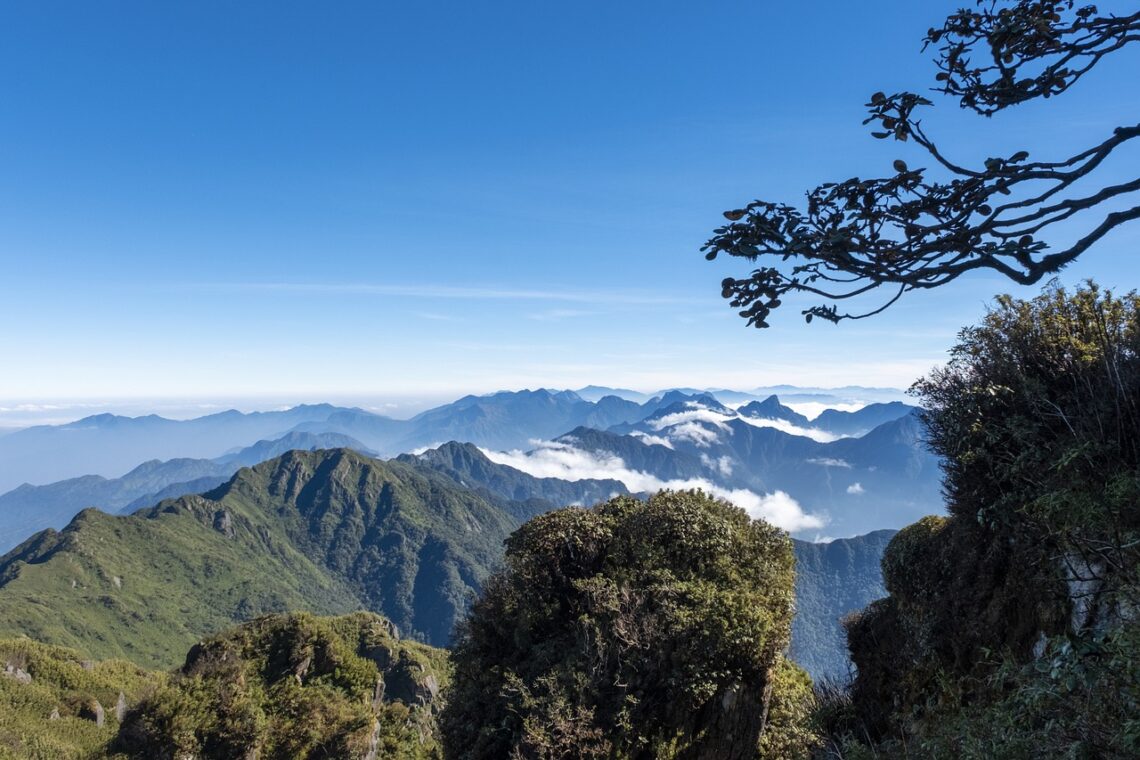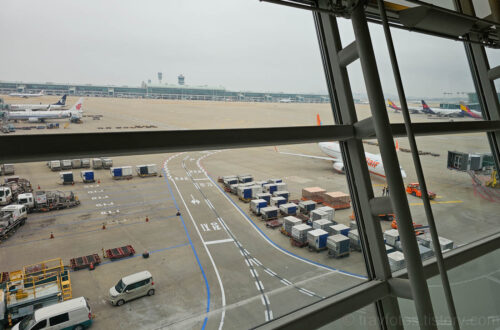Sapa’s weather changes significantly depending on the season. Summers are not too hot, while winters are relatively mild. Located at an altitude of 1,500 meters, temperatures in Sapa can rise up to 27°C during the day and occasionally drop below freezing at night. July and August are the hottest months, while December and January are the coldest. The rainy season lasts from May to September, with the heaviest rainfall typically occurring in July and August.
Spring in Sapa (March to May)
Spring in Sapa lasts from March to May. At the beginning of March, temperatures average around 20°C, with mornings typically around 16–18°C. The weather is generally dry and clear, although it can feel a bit chilly at night. Since spring is a season of frequent rain showers, it’s a good idea to carry an umbrella. This time of year, the landscape is painted with vibrant colors as flowers and plants bloom.
Recommended clothing:
Although daytime is warm, mornings and evenings can be cool, so bring light knits or long-sleeve shirts, along with a light jacket or windbreaker. Sneakers or trekking shoes are ideal.
March:
Spring gradually arrives in Sapa in March. Temperatures range from 8–18°C, and the days start to feel warmer. Colorful flowers begin to bloom across the mountains and fields, making it a pleasant time to travel. Mornings and evenings are chilly, so a light jacket is recommended.
April:
April is one of the best months to visit Sapa. Temperatures range between 12–22°C with clear skies and cool breezes. While the daytime is warm, the large temperature gap means evenings can be quite cool. Bring lightweight long-sleeve clothing and an outer layer.
May:
May marks the beginning of the watering season for the rice terraces, creating spectacular scenery. Temperatures range from 15–25°C, making it quite warm. Occasional showers are common, so pack a thin raincoat or waterproof jacket. Breathable clothing is highly recommended.
Summer in Sapa (June to August)
Summer in Sapa runs from June through August and is characterized by frequent showers. It is the hottest season, with peak daytime temperatures exceeding 30°C, but nights remain cool. Many visitors come to Sapa during summer for hiking, trekking, and camping.
Recommended clothing:
Due to frequent rain and high humidity, bring breathable short-sleeved shirts and lightweight trousers. A thin raincoat or waterproof jacket is essential for sudden rain showers, and waterproof shoes are also highly recommended.
June:
June marks the beginning of the rainy season. Temperatures range from 18–27°C, and the weather is hot and humid. Sudden showers are common, especially in the afternoon and evening. If you’re planning to trek, bring waterproof gear and extra shoes.
July:
July is one of the rainiest months in Sapa. Temperatures average between 19–26°C. Frequent rain can make trails slippery and challenging for trekking. It’s wise to plan for indoor activities or café visits on rainy days.
August:
August remains under the influence of the rainy season, with temperatures around 18–26°C, similar to July or slightly cooler. During the day, you’ll experience strong sunlight combined with high humidity. Light, breathable clothing and a raincoat or umbrella are must-haves.

Autumn in Sapa (September to November)
From September to November, Sapa enjoys autumn weather with average temperatures ranging from 4–6°C at night to 11–20°C during the day. This is the harvest season, where you can see the golden hues of the ripening rice fields. Rainfall significantly decreases compared to summer, making it ideal for camping and trekking.
Recommended clothing:
Due to the large daily temperature range, pack long-sleeve tops, cardigans, hoodies, and light outerwear like windbreakers.
September:
The rainy season gradually ends, and cooler autumn weather begins. Average temperatures hover around 16–24°C, making it a comfortable and beautiful season for travel. It’s the perfect time to photograph the golden rice terraces. Lightweight long sleeves and an outer layer are recommended.
October:
October offers some of the best weather in Sapa, with temperatures between 14–22°C. The days are sunny and the air is crisp, ideal for outdoor activities like trekking and riding the Fansipan cable car. Mornings and evenings are chilly, so bring a light sweater or jumper.
November:
November marks late autumn, with temperatures dropping to 10–20°C as Sapa prepares for winter. The weather is mostly dry and clear, perfect for travel, but early mornings and nights can be quite cold. Bring long sleeves and a thick coat.
Winter in Sapa (December to February)
From early December through February, Sapa experiences its coldest season. Temperatures can drop to as low as 1°C, and it sometimes dips below freezing at night. Snow occasionally blankets the mountains, creating a European-like winter landscape. Fog is frequent, and it rains often. Despite the cold, many travelers visit to experience the snow, enjoy hotpot meals, and sip corn wine by a warm fire.
Recommended clothing:
Pack thermal underwear, Heattech tops, knits, thick padded jackets, and down coats. Don’t forget gloves, scarves, beanies, and insulated boots.
December:
December marks the start of the winter season. Average temperatures are between 5–15°C, but it can drop close to 0°C at night. Higher elevations may experience frost or snow. Warm padded jackets and winter accessories are essential.
January:
January is the coldest month, with frequent days below 5°C. Mornings and evenings can be close to freezing. Expect mostly cloudy days with limited sunshine. Thermal innerwear and heavy winter clothing are necessary.
February:
February remains cold with average temperatures between 4–10°C. Although there may be occasional sunny spells, most days are damp and cloudy. With the chilly wind and high humidity, it can feel even colder, so winter attire is still needed.
Best Time to Visit Sapa
The peak tourist season in Sapa is from June to August, when many domestic travelers visit. To avoid the crowds and enjoy clearer skies, it’s best to visit from March to May or from September to November. September, the harvest season, is particularly beautiful for trekking and sightseeing.
| Month | Avg High Temp (°C) | Avg Low Temp (°C) | Rainfall (mm) | Sunrise Time (1st) | Sunset Time (1st) |
| January | 12.5 | 6.2 | 63 | 06:43 | 17:31 |
| February | 14.1 | 7.5 | 81 | 06:43 | 17:52 |
| March | 18.1 | 10.7 | 106 | 06:25 | 18:08 |
| April | 21.2 | 13.8 | 213 | 05:57 | 18:19 |
| May | 22.4 | 16.3 | 346 | 05:32 | 18:31 |
| June | 22.8 | 17.6 | 410 | 05:20 | 18:44 |
| July | 23.0 | 17.7 | 465 | 05:24 | 18:52 |
| August | 23.1 | 17.4 | 449 | 05:36 | 18:45 |
| September | 21.6 | 15.9 | 313 | 05:47 | 18:21 |
| October | 19.0 | 13.5 | 215 | 05:55 | 17:51 |
| November | 15.9 | 10.1 | 112 | 06:08 | 17:27 |
| December | 13.4 | 6.9 | 64 | 06:27 | 17:19 |






